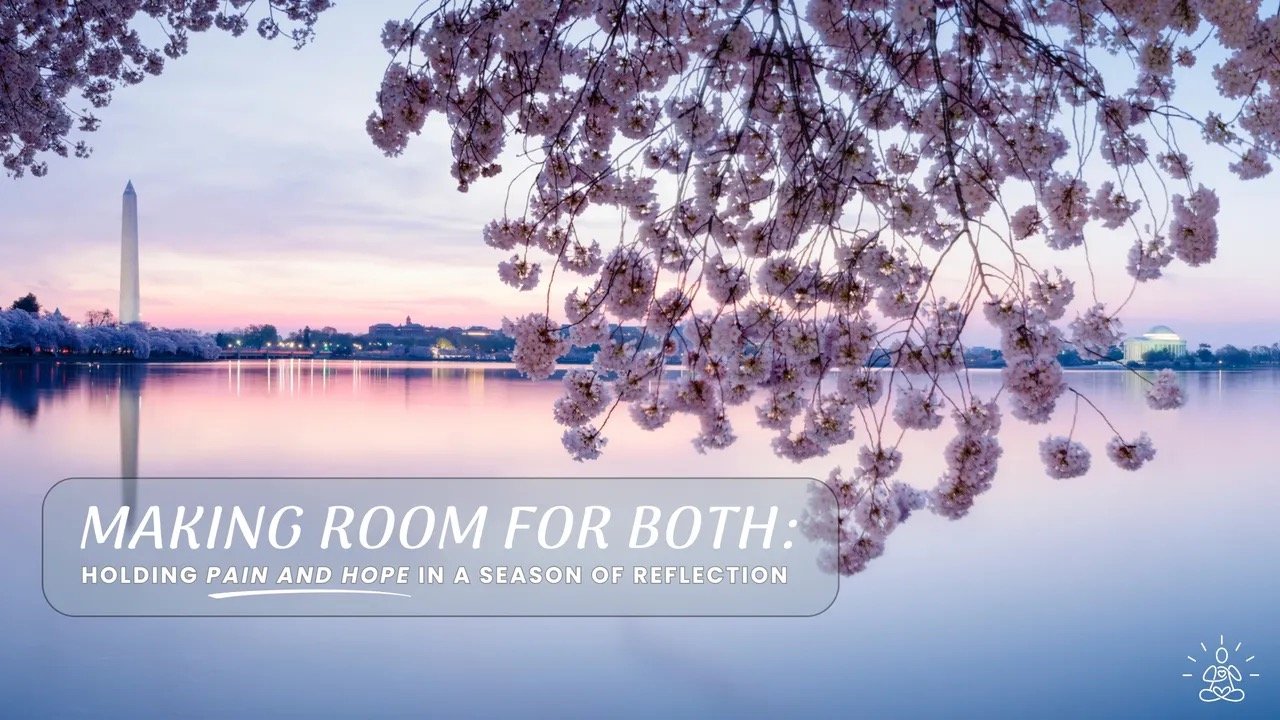Making Room for Pain and Hope in a Season of Reflection
Spring is blooming. The days are longer, the air feels softer, and the world around us is waking up. And yet, many people are feeling emotionally heavy. For some, it’s personal: the weight of grief, burnout, or uncertainty about what’s next. For others, it’s more collective.
There is an uneasiness about the times we’re living in. Whether it shows up as anxiety, anger, or a even sense of righteous urgency, it’s hard not to feel the tension in the world right now. Many are simply trying to hold it all together, wondering what it means to stay grounded in such a polarized world.
If that’s you, you’re not alone. And you’re not doing anything wrong. You’re just human, and this might be a season for holding both.
The Lie of “Either/Or” Thinking
So many of us were taught that we need to “choose” between our feelings. Be positive or negative. Move on or fall apart. Grieve or be grateful. But the truth is, emotional healing doesn’t work that way. Growth rarely happens in neat, linear stages.
In my work as a therapist, I often see people put pressure on themselves to feel one “correct” emotion at a time. If they’re sad, they feel guilty for not being more grateful. If they’re healing, they wonder why they’re still angry. If they’re joyful, they fear it won’t last.
But healing lives in the gray. You can feel joy and grief. You can feel hopeful and uncertain. You can be strong and tired.
A Week of Contrasts and Deep Meaning
This week, as many observe Good Friday and Easter, I’ve been reflecting on what this time represents. Good Friday is a day of sorrow, grief, and reflection. Easter is a day of light, rebirth, and hope. Whether or not you celebrate these holidays in a religious way, the themes are deeply human.
There is something powerful about sitting with the discomfort of pain, without rushing to fix it, and trusting that hope can still emerge. That’s what this season reminds us: light doesn’t cancel out the dark; it coexists with it.
What It Looks Like to Hold Both
So how do we actually practice this — holding space for more than one truth at a time? Here are a few ideas to consider:
1. Let your emotions coexist without forcing a resolution
Feelings, even those that seem to contradict each other, can exist side by side. You don’t have to explain or justify them. Simply noticing them is enough. Let your emotions surface. Notice them without judgment. Accept that they are part of your experience right now and that they don’t need to be solved in order to be valid.
Begin to notice the “and” moments — the in-between spaces where complexity lives. You might find yourself laughing through tears, feeling nervous but still showing up, or remembering something painful while also realizing how far you’ve come. These experiences are not signs of confusion; they are signs of growth. You are not denying your pain, nor are you waiting for it to disappear before allowing in joy, courage, or love. You are learning to hold both, and that in itself is healing.
2. Be intentional with the spaces you enter
It is okay to distance yourself from conversations or online spaces that are not serving you well. Staying informed is important, but constant exposure to inflammatory commentary, negativity, or sensationalized updates can wear on your nervous system and distort your sense of what is possible or true. If a particular space leaves you feeling consistently angry, helpless, or depleted, it may be worth stepping back, whether that means limiting your exposure or removing yourself altogether. Choose spaces that support clarity, connection, and rootedness, not just stimulation.
3. Create rituals of reflection and renewal
Whether it is journaling, lighting a candle, walking in silence, or listening to music that grounds you, give yourself space to pause and reconnect. These rituals are not about escaping reality; they are about creating room to hear yourself think, feel, and simply be. They help you focus on what is within your control — your breath, your pace, your presence — rather than becoming overwhelmed by everything happening outside of you. In moments when the world feels chaotic, small intentional acts can help you reclaim your power and return to yourself.
4. Take meaningful action that reflects your values
Once you’ve made space to feel and reflect, consider how you can direct your energy toward actions that align with your values. Hope is not passive; it is active, and often it is expressed through the small, intentional choices we make every day. Maybe that looks like checking in on a friend who’s been quiet lately, volunteering your time or skills to help someone in need, mentoring a young person who reminds you of your younger self, or choosing to support a business that reflects your ethics. These acts may feel small, but they are powerful. They remind you that your presence makes a difference. That you still have power. That even in the midst of pain, it’s possible to plant seeds of something better.
Gentle Encouragement for the Season Ahead
You don’t have to choose between being in pain or being okay. You’re allowed to be both.
Healing is not about reaching a finish line. It is about expanding your capacity to hold what is real. And sometimes, what is real is messy, complicated, beautiful, or bittersweet...all at once.
If this season feels heavy, I hope you’ll remember that there is still light. There is still love. There is still room for your hope, even if it feels quiet or small.
You are not alone in navigating these complex emotions. At Graceful Mind Therapy, I help women create space for healing and growth by honoring both the pain and the possibilities. If you're feeling stretched thin or unsure how to move forward, therapy can be a grounding place to begin again.
If you’d like to learn more about who I am and how I work, you can visit the About Maria page.
You don’t have to carry it all alone. Support is here, and healing is possible. One moment at a time.
by Maria Perdomo-Torres, LCSW-S, MHA, CFSW




